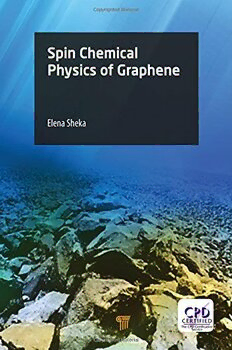
Spin Chemical Physics of Graphene PDF
Preview Spin Chemical Physics of Graphene
Spin Chemical Physics of Graphene Pan Stanford Series on Renewable Energy — Volume 2 Spin Chemical Physics of Graphene Elena Sheka editors Preben Maegaard Anna Krenz Wolfgang Palz The Rise of Modern Wind Energy Wind Power for the World Published by Pan Stanford Publishing Pte. Ltd. Penthouse Level, Suntec Tower 3 8 Temasek Boulevard Singapore 038988 Email: [email protected] Web: www.panstanford.com British Library Cataloguing-in-Publication Data A catalogue record for this book is available from the British Library. Spin Chemical Physics of Graphene All rights reserved. This book, or parts thereof, may not be reproduced in any form Copyright © 2018 by Pan Stanford Publishing Pte. Ltd. or by any means, electronic or mechanical, including photocopying, recording or any information storage and retrieval system now known or to be invented, without written permission from the publisher. For photocopying of material in this volume, please pay a copying fee through the Copyright Clearance Center, Inc., 222 Rosewood Drive, Danvers, MA 01923, USA. In this case permission to photocopy is not required from the publisher. ISBN 978-981-4774-11-6 (Hardcover) ISBN 978-1-315-22927-0 (eBook) Printed in the USA To the memory of Valentin Zayets, one of the outstanding quantum chemists and my unforgettable friend Reviews The age of nanosystems was eventually consecrated from the fullerene discovery contemporarily strengthened by the ever- “ growing mathematical–chemical topological studies of its organic precursors, especially benzenoid systems; however, the fullerene’s rather limitative technological readiness level in real applications damped the true potential of the “bottom world” as it was earlier predicted. The rise of graphene opened a new hope with a promise to revive the transdisciplinary nanosciences as physics and chemistry provide. This book by Dr. Sheka aptly serves the purpose of securing the graphene promise in being a reliable structural support, a versatile easy-to-integrate tool, and a means through which the wave−corpuscular complementary nature of nanomatter finally finds its true representative in both fundamental science and intelligent nanotechnologies. It is a compendium and an open book alike: It provides ultimate structural information and orients the graphenic framework for the real application by employing the spin (true quantum) nature of the electronic structure on the graphenic-landia. From quantum classics to quantum relativistic as well as to magnetic features and the chemical basic processes, such as hydrogenation, oxidation, and redox, and even to mixed systems when the scattering investigation is about (especially by neutrons’ scattering) or by spin mechanochemistry, spin topochemistry, and photonics on the graphenic quantum dots, all are synergistically presented in a complex nanoscale analysis. Besides, the book succeeds in making the step toward the characterization of silicenic and tetrelenic structures while learning the fullerenic–graphenic lessons and in assuring the molectronic context by which the future smart molecular spin–based electronics will be structurally explored for sustainable design and function. Prof. Dr. habil. Mihai V. Putz ” West University of Timişoara, Romania viii Reviews Speckled with the resourceful cogitations of Roald Hoffmann, the tome is an excellent guidebook in the mysterious world of graphene, its “ derivatives, and its analogues, where the chemistry and physics of this seemingly magical material are explained by systematic application of Löwdin’s unrestricted approach in quantum chemistry, avoiding the introduction of periodic boundary conditions. The interplay between radicalization and electron correlation and the treatment of graphene as an open-shell system allow the rationalization of its peculiarities and provide a remarkable correspondence to the experimental data. The narrative is captivating and easy to follow without excessive formalism or oversimplification. The overview of a huge amount of calculations and experiments on pristine and modified graphene reported in the literature is particularly useful, but its critical and comprehensive analysis makes it even more valuable for the reader. Prof. Dr. Alia Tadjer ” Sofia University, Bulgaria This book represents something very new with respect to the immense editorial scenario devoted to the miracle material graphene. It cannot “ simply be considered as a different point of view useful to look at a ‘ ’ material under scientific or technological light, because for the first time, physics and chemistry of graphene have really been interlaced. The core of the approach used to describe the reality of graphene is the interpretation of its chemical/physical properties on the basis of spin effects derived from quantum-chemical computations. This cutting- edge perspective could be a source of inspiration for scientists and young researchers, encouraging further developments and attractive applications for such a fascinating nanomaterial. Prof. Maria Letizia Terranova ” University of Rome Tor Vergata, Italy Contents ix Contents Preface Introduction xvii 1. Open-S h ell Molecules, Unrestricted Hartree–Fock xix Formalism, Electron Correlation, and Spin–Orbit Coupling 1 1.1 Introduction: Molecular–Crystalline Dualism of Graphene and the Ground of Its Spin Chemical Physics 2 1.2 Graphene as an Object with Open-Shell Electronic System sp 5 1.2.1 About Open-Shell Molecules in General 5 2 1.2.2 Reality of the UHFs pPeculiarities of Open-Shell Molecules 9 2 1.3 What Is the Origin of the OSMs UHF Peculiarities? 11 1.4 Nonrelativistic and Relativistic UHF Formalism 13 1.4.1 Hamiltonian 14 1.4.2 Wavefunctions 15 1.4.3 Analytical Results sp 15 1.4.4 Computational Justifications 16 2 1.5 Correlationsp and Relativity Effects in OSMs 18 1.5.1 Phenomenological UHF Peculiarities 2 of OSMs 18 1.5.2 Phenomenological Characteristicssp of Spin–Orbit Coupling in Molecules 21 2 1.5.3 Para- and Ferrodiamagnetism of OSMs 23 1.6 Attempted UHF-Based Determination of SOC Parameters 28 1.6.1 A Confine Collection of Neceassarys p Relations 28 SO 2 1.6.2 UHF-Based SOC Parameter of Nanocarbons 30 1.7 Conclusion 32
